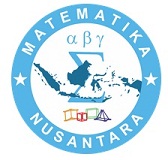PEMAHAMAN MAHASISWA TERHADAP PERSAMAAN DIFERENSIAL BIASA BERDASARKAN TEORI APOS
Abstract
ABSTRACT
Differential equations is used to make the mathematical modeling which is describes the phenomenon in real life problems. It is one of the important concepts to learning the applied mathematics. It is become the main subject for students in mathematics, physics, and engineering field. This study aim to describe how students learn and understand the concept of ordinary differential equations based on APOS theory. The subject of this study was 33 students of semester 5B mathematics educations of private University in Palembang, South Sumatera. Data were collective through test and interview. The result showed that students’ understanding of ordinary differential equations only in action phase. Most of students’ couldn’t understand the next phase in APOS theory because the lack of the derivative and integral concept in form of exponential and logarithm function.
Keywords:Exponential Function, Ordinary Differential Equations, APOS Theory
Full Text:
PDFReferences
Czocher, J.A., Tague, J., & Baker, G. (2013). Coherence from Calculus to Diferential Equations. Tersedia :
http://pzacad.pitzer.edu/~dbachman/RUME_XVI_Linked_Schedule/rume16_submission_94.pdf.
Dubinsky, E. (1991). Reflective Abstraction in Advanced Mathematical Thinking. Tersedia : http://www.math.kent.edu/~edd/RAMT.pdf.
Dubinsky, E., et al. (1995). Understanding the Limit Concept: Beginning with a Coordinated Process Schema. Tersedia : http://homepages.ohiodominican.edu/~cottrilj/concept-limit.pdf.
Dubinsky, E., & McDonald, M.A. (2001). APOS: A Constructivist Theory of Learning in Undergraduate Mathematics Education Research. Tersedia : http://www.math.kent.edu/~edd/ICMIPaper.pdf.
Finizio, N., & Ladas, G. (1988). Persamaan Diferensial Biasa dengan Penerapan Modern. Jakarta : Erlangga.
Helma & Yerizon. (2012). Peningkatan Pemahaman dan Penalaran Matematis Mahasiswa Calon Guru dengan Konstruksi Mental APOS. Tersedia : http://repository.unp.ac.id/1433/1/HELMA_11_12.pdf
Kesumawati, N. (2008). Pemahaman Konsep Matematik dalam Pembelajaran Matematika. Tersedia : http://eprints.uny.ac.id/6928/1/P-18%20Pendidikan%28Nila%20K%29.pdf.
Mallet, D.G., & McCue, S.W. (2009). Constructive development of the solutions of linear equations in introductory ordinary differential equation. International Journal of Mathematical Education in Science and Technology, 40(5), pp. 587-595.
Ningsih, Y.L. (2016). Kemampuan pemahaman konsep matematika mahasiswa melalui penerapan lembar aktivitas mahasiswa (LAM) berbasis teori APOS pada materi turunan. Edumatica, 6(1), hal.1-8.
Nizarwati, Hartono, Y., & Aisyah, N. (2009). Pengembangan perangkat pembelajaran berorientasi konstruktivisme untuk mengajarkan konsep perbandingan trigonometri siswa kelas X SMA. Jurnal Pendidikan Matematika, 3(2), hal. 57-72.
Rohana & Ningsih, Y.L. (2016). Model pembelajaran reflektif untuk meningkatkan kemampuan pemecahan masalah matematis mahasiswa calon guru. Jurnal Penelitian dan Pembelajaran Matematika, Volume 9(2), hal. 145-158. Tersedia pada: http://jurnal.untirta.ac.id/index.php/JPPM/article/view/992/793.
Syarifah, L.L. (2017). Analisis kemampuan pemahaman matematis pada mata kuliah pembelajaran matematika SMA II. Jurnal Penelitian dan Pembelajaran Matematika, Volume 10(2), hal.58-71. Tersedia pada: http://jurnal.untirta.ac.id/index.php/JPPM/article/view/2031/1573
Stewart, S., & Thomas, M. (2009). Linear Algebra Snapshots through APOS and Embodied, Symbolic and Formal Words of Mathematical Thinking. Tersedia : http://www.merga.net.au/documents/Stewart_RP09.pdf
Suhandri. (2016). Meningkatkan kemampuan pemahaman matematis siswa SMP/MTs dengan menggunakan strategi konflik kognitif. Jurnal Penelitian dan Pembelajaran Matematika, Volume 9(2), hal. 240-249. Tersedia pada: http://jurnal.untirta.ac.id/index.php/JPPM/article/view/1003/801.
Tall, D. (1992). Students’ difficulties in calculus. Tersedia : http://homepages.warwick.ac.uk/staff/David.Tall/pdf5/dot1993k-calculus-wg3-icme.pdf.
Tossavainen, T. (2009). Who can solve 2x=1? – an analysis of cognitive load related to learning linear equation solving. The Montana Mathematics Enthusiast, 6(3), pp. 435-448.
Valcare, M.C, & Diaz, J. P. (2013). Initial Diagnostic Assessment to Support Learning. Tersedia :http://cerme8.metu.edu.tr/wgpapers/WG14/WG14_Codes_Valcarce.pdf.
Weber, K. (2002). Students’ Understanding of Exponential and Logarithmic Functions. Tersedia : http://www.math.uoc.gr/~ictm2/Proceedings/pap145.pdf
DOI: http://dx.doi.org/10.30870/jppm.v11i1.2995
Refbacks
- There are currently no refbacks.
Copyright (c) 2018 Jurnal Penelitian dan Pembelajaran Matematika
Ciptaan disebarluaskan di bawah Lisensi Creative Commons Atribusi 4.0 Internasional .
JPPM (Jurnal Penelitian dan Pembelajaran Matematika). Jurnal ini diterbitkan oleh Jurusan Pendidikan Matematika FKIP Universitas Sultan Ageng Tirtayasa (cetak) dan Jurnal Untirta (eprint).
Alamat Penerbit: Jl. Raya Ciwaru No 25 Kota Serang Banten, Jurusan Pendidikan Matematika, Fakultas Keguruan dan Ilmu Pendidikan, Universitas Sultan Ageng Tirtayasa, Kampus Ciwaru, Serang, Banten, Indonesia. Telepon / Faks: (0254) 280330 Ext 111, Email: [email protected] |Klik untuk mengakses: Jurnal Penelitian dan Pembelajaran Matematika


